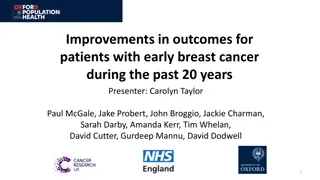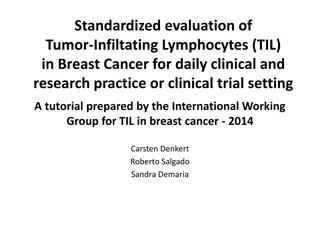Therapies and Strategies for ER-Positive, HER2-Negative Metastatic Breast Cancer
Explore the selection and sequence of therapy for ER-positive, HER2-negative metastatic breast cancer, along with novel agents and strategies under evaluation. Learn about cases of postmenopausal women with metastatic breast cancer, CDK4/6 inhibitors, and the impact of targeted therapies on patient outcomes. Delve into the complexities of treating advanced breast cancer, including the role of various inhibitors and potential new targets for more effective management.
Download Presentation

Please find below an Image/Link to download the presentation.
The content on the website is provided AS IS for your information and personal use only. It may not be sold, licensed, or shared on other websites without obtaining consent from the author.If you encounter any issues during the download, it is possible that the publisher has removed the file from their server.
You are allowed to download the files provided on this website for personal or commercial use, subject to the condition that they are used lawfully. All files are the property of their respective owners.
The content on the website is provided AS IS for your information and personal use only. It may not be sold, licensed, or shared on other websites without obtaining consent from the author.
E N D
Presentation Transcript
Please note, these are the actual video-recorded proceedings from the live CME event and may include the use of trade names and other raw, unedited content.
Selection and Sequence of Therapy for ER-Positive, HER2-Negative Metastatic BC (mBC); Novel Agents and Strategies Under Evaluation in ER-Positive Disease Fabrice ANDRE Gustave Roussy
Disclosures AstraZeneca Pharmaceuticals LP, Lilly, Novartis, Pfizer Inc, Roche Laboratories Inc Contracted Research
A postmenopausal woman in her mid-50s with strongly ER/PR- positive, HER2-negative metastatic breast cancer (Dr Andr ) 7 years ago: 2.5-cm, Grade 1 ER-positive (100%), PR-positive (80%), HER2- negative IDC with 6 positive nodes and low Ki-67 (8%) Conservative surgery adjuvant chemotherapy, radiation therapy and 5 years of adjuvant letrozole Metastases from adenocarcinoma of the breast to cervical lymph node, iliac bone and L1 spine ER-positive (80%), PR-positive (70%), HER2 IHC1+, Ki-67 low
A woman in her mid-70s with de novo ER/PR-positive, HER2- negative metastatic breast cancer to the liver (Dr Andr ) 5-cm ER-positive (60%), PR-positive (40%), HER2-negative (IHC1+) IDC, with a Ki-67 of 30% Scan: Massive involvement of the liver ALT 2-fold increase, bilirubin normal, PS = 1 Palbociclib and letrozole Progressive disease after 20 months
Outline CDK4/6 inhibitors: transformative or incremental? PI3K inhibitors: how to use them? What is their potential value? New targets
CDK4 pathway Cell signaling Regulates expression p21 p16 ER Cyclin D1 CDK4 P P Rb Rb E2F E2F G1/S transition cell proliferation Hamilton E & Infante JR. Cancer Treat Rev. 2016;45:129 138.
Impact of CDK4/6 inhibitors (abemaciclib, palbociclib, ribociclib) on PFS PFS HR compared to endocrine alone Line Trial Schema First line PALOMA-1 Letrozole palbociclib 0.49 PALOMA-2 Letrozole palbociclib 0.58 MONALEESA-2 Letrozole ribociclib 0.56 MONALEESA-7 NSAI/tamoxifen ribociclib 0.55 MONARCH 3 Letrozole or anastrozole, abemaciclib 0.54 Second line PALOMA-3 Fulvestrant palbociclib 0.46 MONARCH 2 Fulvestrant abemaciclib 0.55 MONALEESA-3 Fulvestrant ribociclib 0.57
Impact on OS Turner NC et al. N Engl J Med 2018;379(20):1926-36.
Phase III MONALEESA-7 trial of premenopausal patients with HR+/HER2 advanced breast cancer (ABC) treated with endocrine therapy ribociclib: Overall survival (OS) results. Hurvitz SA et al. ASCO 2019;Abstract LBA1008. Oral Abstract Session, Tuesday, June 4, 11:57 AM - 12:09 PM, Hall D1
Safety profile Palbo-letrozole Ribo-letrozole Abema-letrozole Neutropenia (grade 3/4) 62% 59% 21% Anemia (any grade) 28% (vs 11%) 20% (vs 5%) 28% (vs 5%) Thrombocytopenia (grade 3/4) 2% (vs 0%) NR NR Fatigue (any) 39% (vs28%) 38% (vs 30%) 40% (vs 31%) QT prolongation (>480 msec) NR 3% NR Diarrhea (grade 2-4) 0% 1% (grade 3) 36% Alopecia (any grade) 15% (vs 6%) 33% (vs 15%) 26% (vs 10%) Increased Alanine Amino Transferase NR 9% (vs 1%) 6% (vs 2%) Phlebitis (any) Overincidence not well assessed, but signal Finn, NEJM, 2016, Hortobagyi, NEJM, 2016, Goetz, J Clin Oncol, 2018
Abemaciclib for brain metastases: CNS concentration in ongoing Phase II study Plasma, CSF, and Resected Tumor Tissue Concentrations of Abemaciclib Patients with brain metastases 1000 Abemaciclib Plasma CSF Tissue Part B: HR+/HER2- breast cancer (23 to 56 patients) 100 Part A: HR+/HER2+ breast cancer (23 to 56 patients) Part D: NSCLC Part E: Melanoma (23 to 56 patients) (23 to 56 patients) 10 Primary endpoint: Objective intracranial response rate 1 0.1 Exploratory Patient 1 Patient 2 Patient 3 Measurable levels of abemaciclib were detected in brain tumor tissue. Part C: HR+ breast cancer, NSCLC or melanoma and clinically indicated for surgical resection (after receiving 5-14 days of therapy) (~8 patients) Part F: HR+ breast cancer, NSCLC or melanoma and leptomeningeal metastases ( parenchymal brain metastases) (~15 patients) Concentrations of abemaciclib in the plasma and tumor tissue were comparable and consistent with the CSF concentration for each of the patients. Sahebjam S et al. Proc ASCO 2016;Abstract 526.
Abemaciclib for ER+ brain metastases Efficacy population patients with response N = 23 CNS ResponseaSummaryb OIRR, n (%), (95% CI) 2 (8.7), (0.0, 20.2) CR, n (%) 0 PR, n (%) 2 (8.7) SD, n (%) 10 (43.5) % Change from Baseline SDc 6 months, n (%) 2 (8.7) PD or early death, n (%) 8 (34.8) CBR, n (%), (95% CI) 4 (17.4), (1.9, 32.9) CR SD PR PD NE Received concomitant endocrine therapy Tumors previously treated with WBRT Tumors previously treated with SRS Individual Patients a Response criteria per RANO-BM. b 6 patients had no postbaseline tumor measurements and therefore were not included in this waterfall plot. c Patients with SD 6 months are included in the number of patients with SD. Tolaney S et al. Proc ASCO 2017;Abstract 1019.
Predictive biomarkers on baseline samples (validated in several independent studies) Cell signaling RB1 mutations p21 p16 Cyclin E CDK2 Cyclin D1 CDK4 P CCNE1 expression P Rb Rb E2F Bertucci F et al. Nature 2019;569:560-4. E2F G1/S transition cell proliferation Turner NC et al. J Clin Oncol 2019;37(14):1169-78. Hamilton E & Infante JR. Cancer Treat Rev. 2016;45:129 138.
Outline CDK4/6 inhibitors: transformative or incremental? PI3K inhibitors: how to use them? What is their potential value? New targets
PI3 kinase pathway Isoforms of catalytic subunit 30-40% activating mutations of PIK3CA in HR+/HER2 mBC PI3K Catalytic subunit p110 Regulatory subunit p85 Cell cycle metabolism AKT PIP2 PIP3 PTEN
SOLAR-1: A Phase III randomized, controlled trial (NCT02437318) ALP 300 mg QD PO + FUL 500 mg IM* n=169 PBO + FUL 500 mg IM* n=172 PIK3CA- mutant cohort (PCR, exon 7,9,20) (n=341) Men or postmenopausal women, with HR+, HER2 ABC Recurrence/progression on/after prior AI Identified PIK3CA status (in archival or fresh tumor tissue) Measurable disease or 1 predominantly lytic bone lesion ECOG performance status 1 (N=572) Primary endpoint PFS in PIK3CA-mutant cohort (locally assessed) R Secondary endpoints include: OS (PIK3CA-mutant cohort) PFS (PIK3CA-non-mutant cohort) PFS (PIK3CA mutation in ctDNA) OS (PIK3CA-non-mutant cohort) ORR/CBR Safety 1:1, stratified by presence of liver/lung metastases and prior CDK4/6 inhibitor treatment ALP 300 mg QD PO + FUL 500 mg IM* n=115 PBO + FUL 500 mg IM* n=116 PIK3CA-non- mutant cohort (n=231) R *Fulvestrantgiven on Day 1 and Day 15 of the first 28-day cycle, then Day 1 of subsequent 28 day cycles.
Impact of alpha-specific PI3K inhibitors (SOLAR-1 trial) Alpelisib + fulvestrant (N=169) Placebo + fulvestrant (N=172) Data cut-off: Jun 12, 2018 Number of PFS events, n (%) Median PFS (95% CI) HR (95% CI) p-value 103 (60.9) 129 (75.0) 11.0 5.7 (7.5 14.5) (3.7 7.4) 0.65 (0.50 0.85) 0.00065 No effect on PIK3CA-WT Preliminary OS: HR:0.73 (0.48-1.10) Andre F et al. N Engl J Med 2019;380(20):1929-40; Juric D et al. SABCS 2018;Abstract GS3-08.
Adverse events in the total population Alpelisib + fulvestrant N=284 Grade 3 183 (64.4) 93 (32.7) 19 (6.7) 7 (2.5) 2 (0.7) 28 (9.9) 2 (0.7) 11 (3.9) 7 (2.5) 10 (3.5) 5 (1.8) Placebo + fulvestrant N=287 Grade 3 87 (30.3) 1 (0.3) 1 (0.3) 1 (0.3) 1 (0.3) 1 (0.3) 1 (0.3) 0 0 3 (1.0) 0 AEs 20% in either arm, % Any adverse event Hyperglycemia Diarrhea Nausea Decreased appetite Rash* Vomiting Decreased weight Stomatitis Fatigue Asthenia All Grade 4 33 (11.6) 11 (3.9) 0 0 0 0 0 0 0 0 0 All Grade 4 15 (5.2) 1 (0.3) 0 0 0 0 0 0 0 0 0 282 (99.3) 181 (63.7) 164 (57.7) 127 (44.7) 101 (35.6) 101 (35.6) 77 (27.1) 76 (26.8) 70 (24.6) 69 (24.3) 58 (20.4) 264 (92.0) 28 (9.8) 45 (15.7) 64 (22.3) 30 (10.5) 17 (5.9) 28 (9.8) 6 (2.1) 18 (6.3) 49 (17.1) 37 (12.9) Management Hyperglycemia: Early detection: day 8 visit, metformin if glycemia (or Hb1c) above normal level Exclude diabetic patients Andre F et al. ESMO Congress 2018;Abstract LBA3_PR. Management Rash: Topical steroids, antihistamine (prophylaxis ++)
Outline CDK4/6 inhibitors: transformative or incremental? PI3K inhibitors: how to use them? What is their potential value? New targets
List of actionable alterations in breast cancer Condorelli R et al. Ann Oncol 2019;30(3):365-73.
Which genomic alterations are acquired after resistance to ET and could be a target? MethylTransferase: epigenetics ER pathway CDK4 pathway PI3K pathway Bertucci F et al. Nature 2019;569:560-4.
Randomized Phase II Trial of Venetoclax + Fulvestrant versus Fulvestrant in Estrogen Receptor+, HER2 Locally Advanced or Metastatic Breast Cancer Following Recurrence or Progression During or After a CDK4/6 Inhibitor: VERONICA Lindeman GJ et al. ASCO 2019;Abstract TPS1108 Breast Cancer Metastatic Sunday, June 2nd, 2019























